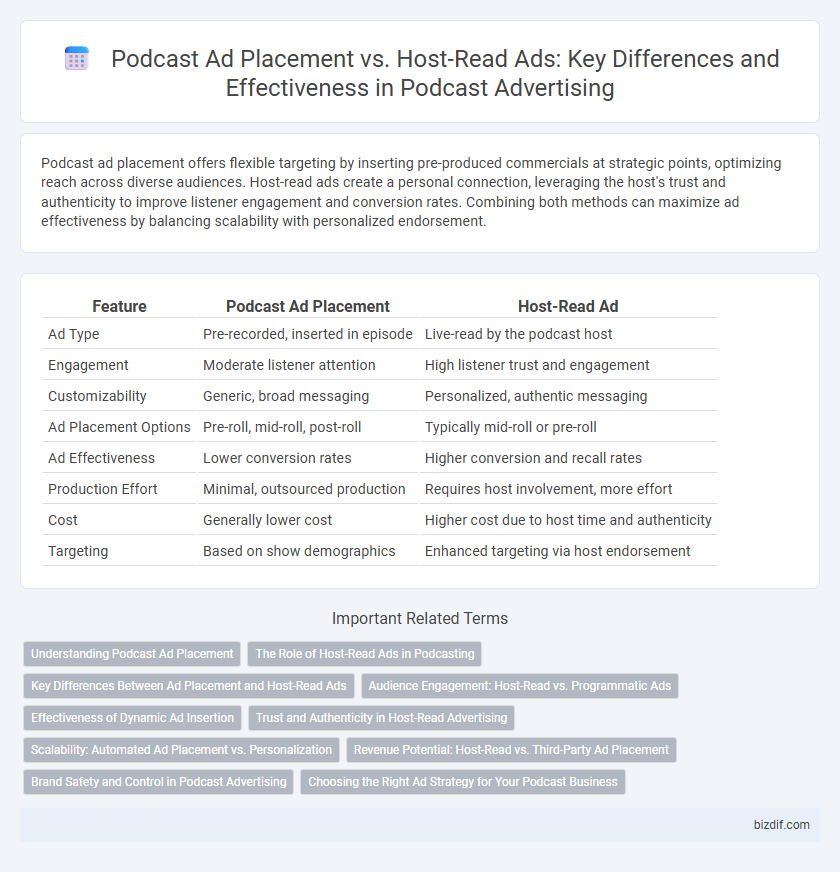Podcast ad placement offers flexible targeting by inserting pre-produced commercials at strategic points, optimizing reach across diverse audiences. Host-read ads create a personal connection, leveraging the host's trust and authenticity to improve listener engagement and conversion rates. Combining both methods can maximize ad effectiveness by balancing scalability with personalized endorsement.
Table of Comparison
| Feature | Podcast Ad Placement | Host-Read Ad |
|---|---|---|
| Ad Type | Pre-recorded, inserted in episode | Live-read by the podcast host |
| Engagement | Moderate listener attention | High listener trust and engagement |
| Customizability | Generic, broad messaging | Personalized, authentic messaging |
| Ad Placement Options | Pre-roll, mid-roll, post-roll | Typically mid-roll or pre-roll |
| Ad Effectiveness | Lower conversion rates | Higher conversion and recall rates |
| Production Effort | Minimal, outsourced production | Requires host involvement, more effort |
| Cost | Generally lower cost | Higher cost due to host time and authenticity |
| Targeting | Based on show demographics | Enhanced targeting via host endorsement |
Understanding Podcast Ad Placement
Podcast ad placement involves strategically inserting advertisements at specific points within an episode, such as pre-roll, mid-roll, or post-roll, to maximize listener engagement and brand recall. Host-read ads leverage the podcast host's authentic voice and established trust with the audience, often leading to higher conversion rates compared to dynamically inserted ads. Understanding the nuances between these approaches helps advertisers optimize campaign effectiveness by aligning ad delivery with listener behavior and episode flow.
The Role of Host-Read Ads in Podcasting
Host-read ads in podcasting create a personalized connection by leveraging the trust between the host and the audience, leading to higher listener engagement and ad effectiveness. These ads seamlessly integrate into the content, enhancing authenticity and increasing recall rates compared to pre-produced ad placements. Research shows host-read ads drive better conversion metrics due to their tailored delivery and natural storytelling within the podcast format.
Key Differences Between Ad Placement and Host-Read Ads
Podcast ad placement involves pre-recorded commercials inserted at designated points in an episode, offering consistent messaging and scalable reach. Host-read ads are personally delivered by the podcast creator, enhancing authenticity and listener trust through natural integration. These key differences impact listener engagement, ad effectiveness, and brand perception within the podcasting ecosystem.
Audience Engagement: Host-Read vs. Programmatic Ads
Host-read ads generate higher audience engagement by creating a personal and trusted connection between the host and listeners, resulting in increased ad recall and brand affinity. Programmatic ads offer scalable and targeted reach but often lack the authenticity and emotional resonance found in host-read endorsements. Studies indicate that host-read ads can boost conversion rates by up to 50% compared to programmatic placements, emphasizing their effectiveness in nurturing listener loyalty.
Effectiveness of Dynamic Ad Insertion
Dynamic ad insertion boosts podcast monetization by targeting listeners with timely, relevant ads, increasing engagement compared to static host-read ads. It enables advertisers to update campaigns in real-time and personalize content based on audience demographics and listening behavior. This technology enhances ad effectiveness through data-driven targeting while preserving the seamless listening experience.
Trust and Authenticity in Host-Read Advertising
Host-read ads in podcasts foster higher trust and authenticity compared to standard ad placements due to the personal connection between the host and their audience. Listeners are more likely to engage with endorsements that feel genuine and tailored, as hosts often share personal experiences with the product or service. This authenticity drives stronger brand loyalty and improves ad effectiveness in podcast advertising campaigns.
Scalability: Automated Ad Placement vs. Personalization
Automated ad placement enables scalable podcast monetization by dynamically inserting ads across multiple episodes and shows without requiring host involvement. Host-read ads deliver personalized endorsements that resonate more authentically with listeners but limit scalability due to time constraints and production effort. Balancing automation's efficiency with the tailored impact of host reads helps maximize revenue potential at scale.
Revenue Potential: Host-Read vs. Third-Party Ad Placement
Host-read ads generate higher revenue potential due to their authentic delivery and direct audience trust, often resulting in improved listener engagement and conversion rates. Third-party ad placements, while scalable and easier to automate, typically yield lower CPMs due to less personalized messaging and reduced listener connection. Data from industry reports shows host-read ads can command CPMs up to three times higher than dynamically inserted third-party ads, highlighting their superior monetization value in podcast advertising.
Brand Safety and Control in Podcast Advertising
Podcast ad placement offers precise control over where and when ads appear, enhancing brand safety by avoiding content that conflicts with brand values. Host-read ads, while more authentic and engaging, can introduce variability and less control over the ad environment. Brands seeking stringent safety measures and message consistency often prefer programmatic ad placement in podcast advertising.
Choosing the Right Ad Strategy for Your Podcast Business
Choosing the right ad strategy for your podcast business involves weighing the effectiveness of host-read ads against programmatic ad placements. Host-read ads deliver personalized, authentic endorsements that boost listener trust and engagement, often leading to higher conversion rates. Programmatic ad placement offers scalability and precise targeting, enabling podcasters to optimize revenue through dynamic ad insertion based on listener demographics and behavior.
Podcast ad placement vs Host-read ad Infographic

 bizdif.com
bizdif.com